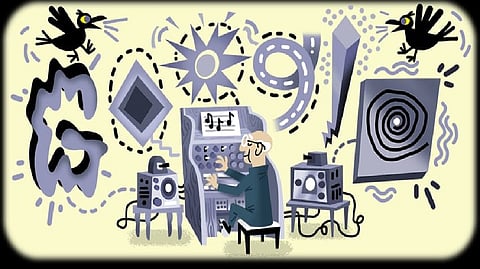Oskar Sala: Facts about pioneer of electronic music to know
CHENNAI: Google doodle on Monday commemorated the 112th birthday of Oskar Sala, the innovative German electronic music composer and physicist.
“Take a beat to celebrate German electronic composer Oskar Sala’s 112th birthday. He developed & played the mixture-trautonium, which introduced a unique sound to television, radio & film,” read Google’s tweet about one of the most important figures and pioneer of electronic music for the 20th century.
Here are a few facts that you need to know about the composer:
1. Sala was born in Greiz, Thuringia in 1910 Germany and was known for developing and composing sound on a musical instrument called the Trautonium, a predecessor to the synthesizer.
2. The mixture-trautonium, which introduced a unique sound to television, radio and movies. “Recognised for producing sound effects on a musical instrument called a mixture-trautonium, Salas electrified the world of television, radio and film," according to the Google doodle page.
3. Sala came from a very musical family. His mother Annemarie (1887-1959) was a singer, and his father Paul (1874-1932) was an ophthalmologist.
4. He was immersed in music since birth and began making compositions and songs for instruments like violin and piano at 14, according to the website.
5. During his teenage life, he studied piano and organ and performed in classical piano concerts.
6. After hearing trautonium for the first time, he became fascinated by its tonal possibilities and the technology the instrument offered. “Then his life mission became mastering the trautonium and developing it further, which inspired his studies in physics and composition at school,” read the Google website.
7. He then, moved to Berlin in 1929, to study piano and composition with composer and violist Paul Hindemith.
8. He also followed the experiments at the school’s laboratory of Dr. Friedrich Trautwein, learning to play with Trautwein's pioneer electronic instrument, the Trautonium.
9. Sala further developed the Trautonium in 1948 into the Mixture-Trautonium. Sala added electronic percussion for percussion set ups to the mixture Trautonium, and later modified it with additional components, such as noise generators and an electric metronome.
10. The field of subharmonics was opened up by Sala's invention, the symmetric counterpart to overtones so that a thoroughly distinct tuning evolved. He also built the Quartett-Trautonium, Konzerttrautonium (Concert Trautonium), and the Volkstrautonium. His Volkstrautoniun was presented to the public at the Berliner Funkausstellung radio exhibition in 1933.
11. With his educational background as a composer and electro-engineer, he created electronic music to his style that made him unique.
12. Sala worked on many films and created musical pieces and sound effects for television, radio, and movie productions.
13. Sala hardly appeared in public in concerts from 1958 and instead worked mostly worked in his Berlin recording studio, Mars film GmbH (4th incarnation). It was there that he produced electronic soundtracks for such films as Veit Harlan's Different from You and Me (1957), Rolf Thiele's Rosemary (1959), and Fritz Lang's Das Indische Grabmal (1959). He also created the non-musical soundtrack for Alfred Hitchcock's film The Birds (1962).
14. He received several awards for his film scores, but he never won an Oscar. He also did much work on German commercials, most notably one referred to as HB's little man.
15. The instrument that Oskar used sounds like a noise of a bird crying, hammering, and door and window slams. The instruments architecture is so unique that it was capable of playing several sounds or voices simultaneously.
16. Notably in 1995, Sala donated his original mixture-trautonium to the German Museum for Contemporary Technology.
17. He became well-known as he went on to give countless interviews, appeared as guest in film festival and talk shows, met numerous artists and was honored in radio broadcasts and movies in the year 1988.
18. He donated his estate to the Deutsches Museum in 2000 and died on February 26, 2002 in Berlin.
Visit news.dtnext.in to explore our interactive epaper!
Download the DT Next app for more exciting features!
Click here for iOS
Click here for Android

